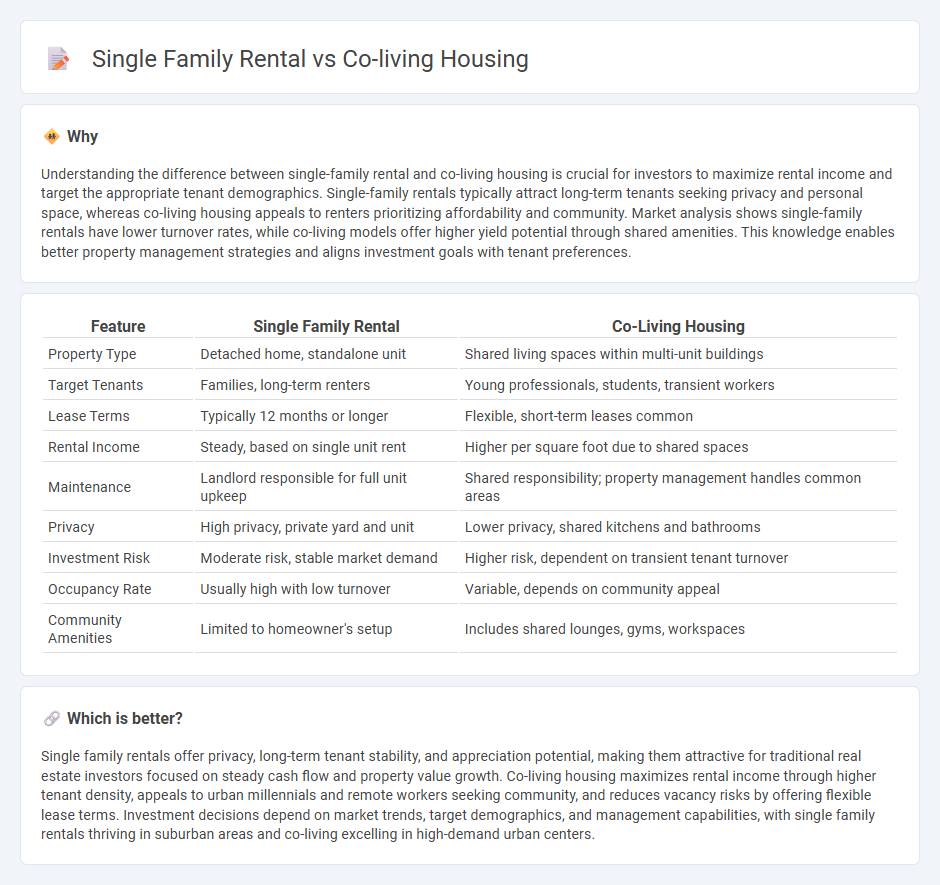
Single family rentals offer privacy and long-term tenancy ideal for families seeking a traditional home environment, while co-living housing provides affordable, community-oriented living spaces popular among young professionals and remote workers. Market trends show single family rentals command stable rental income with lower turnover rates, whereas co-living spaces benefit from higher occupancy rates and shared amenities that reduce individual costs. Explore the advantages and challenges of each housing model to determine the best investment strategy.
Why it is important
Understanding the difference between single-family rental and co-living housing is crucial for investors to maximize rental income and target the appropriate tenant demographics. Single-family rentals typically attract long-term tenants seeking privacy and personal space, whereas co-living housing appeals to renters prioritizing affordability and community. Market analysis shows single-family rentals have lower turnover rates, while co-living models offer higher yield potential through shared amenities. This knowledge enables better property management strategies and aligns investment goals with tenant preferences.
Comparison Table
| Feature | Single Family Rental | Co-Living Housing |
|---|---|---|
| Property Type | Detached home, standalone unit | Shared living spaces within multi-unit buildings |
| Target Tenants | Families, long-term renters | Young professionals, students, transient workers |
| Lease Terms | Typically 12 months or longer | Flexible, short-term leases common |
| Rental Income | Steady, based on single unit rent | Higher per square foot due to shared spaces |
| Maintenance | Landlord responsible for full unit upkeep | Shared responsibility; property management handles common areas |
| Privacy | High privacy, private yard and unit | Lower privacy, shared kitchens and bathrooms |
| Investment Risk | Moderate risk, stable market demand | Higher risk, dependent on transient tenant turnover |
| Occupancy Rate | Usually high with low turnover | Variable, depends on community appeal |
| Community Amenities | Limited to homeowner's setup | Includes shared lounges, gyms, workspaces |
Which is better?
Single family rentals offer privacy, long-term tenant stability, and appreciation potential, making them attractive for traditional real estate investors focused on steady cash flow and property value growth. Co-living housing maximizes rental income through higher tenant density, appeals to urban millennials and remote workers seeking community, and reduces vacancy risks by offering flexible lease terms. Investment decisions depend on market trends, target demographics, and management capabilities, with single family rentals thriving in suburban areas and co-living excelling in high-demand urban centers.
Connection
Single-family rentals and co-living housing both address growing urban housing demands by offering flexible, community-oriented living options. Single-family rentals provide privacy and stability suited for long-term tenants, while co-living housing emphasizes shared spaces and affordable rents for millennials and young professionals. Together, they represent evolving real estate trends focused on affordability, flexibility, and social interaction in high-demand metropolitan markets.
Key Terms
Shared Amenities
Co-living housing offers extensive shared amenities such as communal kitchens, coworking spaces, and recreational areas designed to foster social interaction and convenience. Single family rentals typically include private amenities, with limited shared facilities, emphasizing privacy and individual space. Explore the benefits and challenges of shared amenities in both housing options to determine the best fit for your lifestyle.
Lease Structure
Lease structures in co-living housing often feature short-term, flexible agreements that accommodate individual tenants within a shared property, promoting community living and cost-efficiency. Single family rentals typically involve longer-term, traditional leases binding the entire household, offering stability and exclusive property control. Explore detailed comparisons to determine which lease model aligns with your housing needs and investment goals.
Tenant Demographics
Co-living housing primarily attracts younger tenants, such as millennials and Gen Z professionals, seeking affordability, flexibility, and community-oriented living environments. Single family rentals typically draw families and long-term renters who prioritize privacy, space, and stability in suburban or residential neighborhoods. Explore in-depth tenant demographic trends to understand how these preferences influence rental market dynamics.
Source and External Links
Co-living - Wikipedia - Co-living is a housing model where three or more unrelated people share a dwelling unit, gaining popularity especially in cities facing affordable housing crises, and it promotes sustainability through shared resources.
How Co-Living Is Reshaping Urban Housing - Co-living addresses the need for affordable, flexible, and community-focused living arrangements in urban areas, combining privacy with shared social amenities.
What Is Co-Living Housing and Why Is It on the Rise? - Co-living offers cost savings, a built-in community, convenience, and lease flexibility, making it an attractive alternative to traditional rental housing.
 dowidth.com
dowidth.com